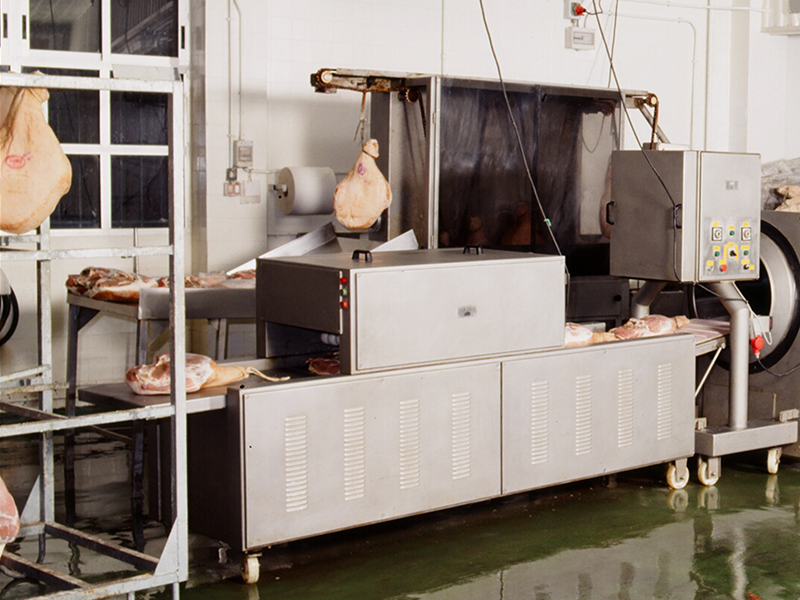
We will never tire of repeating in this blog that this is a traditional, artisanal sector. The essence of making a ham has not varied for hundreds of years. However, now we use technology to be able to produce ham all year round on a large scale while respecting ancestral know-how. Since the industry was mechanised, the volume of production has shot up. However, the first great jump in the sector probably came with industrial refrigeration.
It’s always winter in post-salting
As research moves forwards in general, talking about new technologies and referring to progress from the past century is all the more striking. That’s not to say that progress has ground to a halt in the world of ham. Given its great production volume and its importance in our country, many tests focus on improving the end product day by day. However, it might be the arrival of refrigeration that really revolutionised the sector.
Until only a few years ago, making ham followed a natural cycle, marked by the seasons. The pig was slaughtered as winter came, as the cold helped to keep the meat fresh. Temperatures rose gently during the spring until the heat of the summer and then the cold came back little by little in autumn.
If there were no salting and post-salting chambers, current production would not be feasible. They imitate the winter and help guarantee food security for the ham during its first phase, which is, of course, the most sensitive to microbial contamination. Artificial drying spots help, at certain times of year, to temper the ham like in the spring and prepare them, as in our case, to be taken out to the natural drying spot, just like always, with open windows. Even in these spots, sensors that measure the temperature and the humidity inside and outside set up mechanisms that regulate the opening and closing of windows and forced ventilation to get the optimum atmosphere. In La estrella del jamón’s drying spots, we leave the technology for artificial drying, and depending on what the psychometer measures and our personal experience, we open and close the windows manually.
Mechanising the processes
Although we keep using completely manual techniques for processes such as salting the ham, progress in engineering has created mechanical production lines that encourage greater productivity. In the case of La estrella del jamón, we use both forms. At our Cuarte de Huerva facilities, where we make Jamón Serrano ETG, we use a mechanical salting and washing line, whilst in Monreal del Campo, where our Jamón de Teruel PDO is made, the salting process is done with a shovel.
Machines also arrived to make other tasks easier such as pressing or shaping the salted pieces, that used to be done by hand. For processes such as applying melted lard or oil, although usually done by hand with a brush, there are mechanical larding machines on production lines. Furthermore, in the deboner, rind removers and polishers are used, plus filleting machines that can slice and package hams at a blinding pace. However, each and every one of these processes follows the traditional method and, in most small industries in the sector, either due to investment capacity or in our case, out of a love of tradition, nothing has replaced the hands of operators who work with and know all about ham.
“New” technologies
Despite all this, there is plenty of room for improvement in ham production. Consequently, as we mentioned at the start, there are many research centres that strive for excellent organoleptic qualities for the product.
In the traditional drying spots, raw material is classified depending on its weight, its fat thickness and, in the best of cases, its pH. However, there are ultrasound, magnetic field or resonance systems that offer accurate solutions when classifying pieces, although they are not within reach of all companies, we can imagine that they will be in the not-too distant-future.
We also work on improving the drying process, by developing sensors that make it possible to find out, non-destructively, the concentration of water and salt in each ham at each point in its process. Doubtlessly, this is a more accurate method that simply observing the shrink.
The same happens with IT solutions for traceability. Applied right from arrival in the manufacturing plant, simple systems make it possible by the end of the cycle to reveal all the steps that each ham has taken and draw up a report based on its origin, weight, time in salt or in the different chambers and drying spots with its temperatures and relative humidity.
New technologies are also being applied little by little in characterisation of the final product. So, the use of a so-called “electronic nose” makes it possible to objectively capture the aromas found in the ham, once cured. Or the use of magnetic resonance to reveal the ham’s quantity of fat, humidity, colour and even some sensory attributes before it is cut open.
Surely, we should not forget that ICT – Information and Communication Technologies are within the reach of any company. Internet in general and social media in particular, have democratised marketing, making it much more accessible to all budgets. Thanks to this, we can be here, behind a computer keyboard, giving you the lowdown on our sector, that we believe you’ll find not only interesting but also useful.


